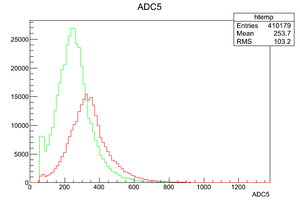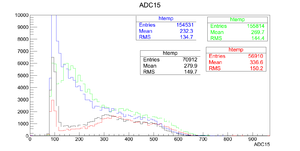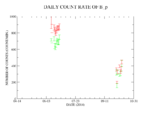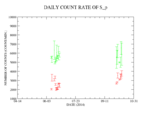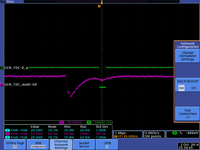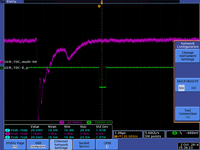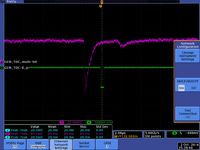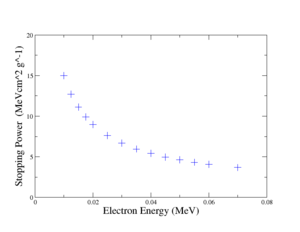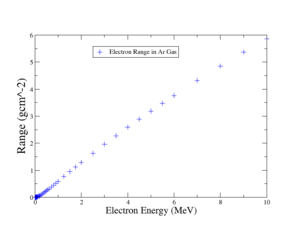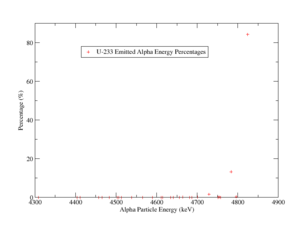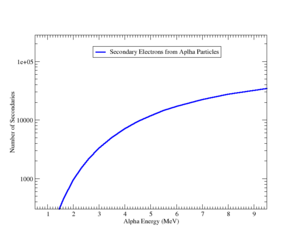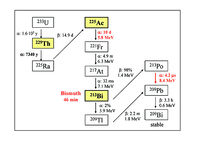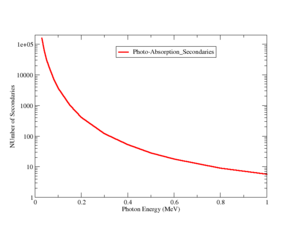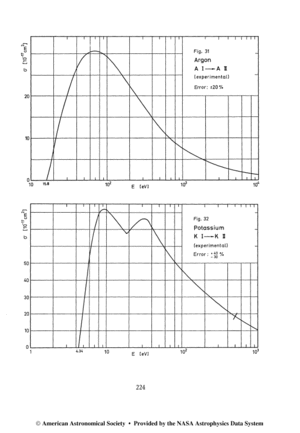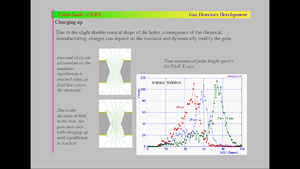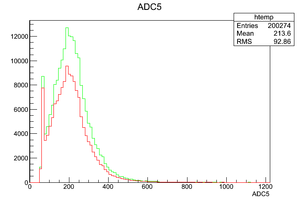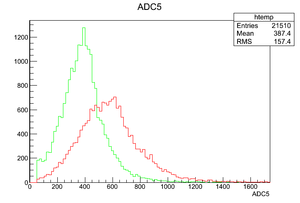HM 2014
10/16/14
you need to label these histograms with more detail that will identify the run number and the run conditions. Name each histogram according to the run number then in a figure caption identify the run conditions.
you need to show more than just 4 runs, try to take 10
- Last update for the today's measurements
- Reproduciblity is achieved when for the peak sensing spectra for shutter open and shutter close without source.
- Increasing the GEm amplification is needed for the case of the shutter open with the source on.
Analyze all runs with same conditions of HV, Gas, … to determine the integral number of counts in the ADC(PADC) histogram that are above the pedestal.
| Shutter | run number | Scaler counts (Hz) | pedestal | Integral in ADC full spectrum (Hz) | Integral in ADC spectrum beyond pedestal (Hz) |
| Open | 7847 | 9006+_ 392/60 | 1429/60 | 7915/60 | 5810/60 |
| Closed | 7846 | 4323+_209/60 | 1070/60 | 4029/60 | 2817/60 |
10/14-15/14
| Shutter | run numbers | average number of counts above the pedestal |
| Open | 7797, 7802, 7808, 7816 | 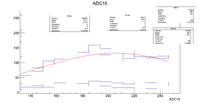 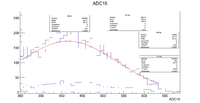
|
| Closed | 7798, 7803, 7809, 7817 | 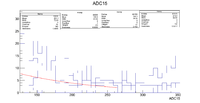 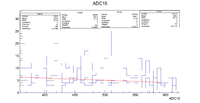
|
Fix the percentage plot for the number of betas emitted by the source.
The repcentages do not add to 100% according to two different references.[1][2] they add to about 20%, the first referece bentioned that the average energy for the emitted particles from U-233 are
Ebeta (eV) : 5.043230e+3 (5.363190e+2)
Egamma (eV) : 1.110210e+3 (1.076780e+2)
Ealpha (eV) : 4.888350e+6 (2.896760e+4)
Fix the alpha log plot for cross-section, change units on the beta plot for cross section so they are in barns.
Add plot for expected voltage on oscilloscope.
| Alpha | 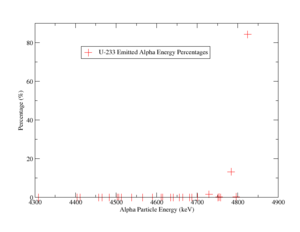 |
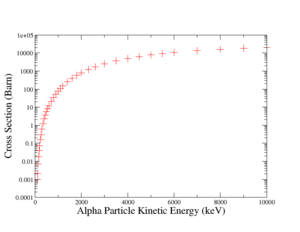 |
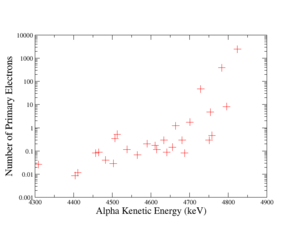
|
| Beta | 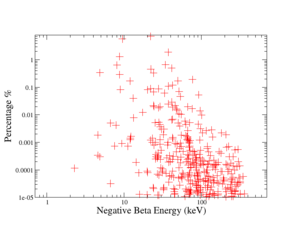 |
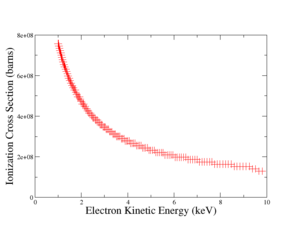 [3] [3] |
|
| Gamma | 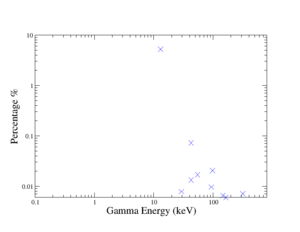 |
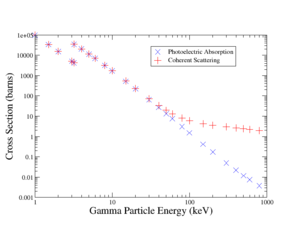 |
300 px |
10/13/14
stripchart
- Relationship between barns and g/cm^2
paragraph describing percentage plots for alpha, beta, and gamma with references.
| long run | time | shutter | source | Notes |
| 7832 | 6h | open | off | 8dB |
| 7834 | 35min | closed | off | 8dB |
| 7836 | 5.5h | open | on | 11 dB |
10/10/14
10/02/14
QDC's and Peak sensing's spectra distinguish between shutter open and shutter close as the source is on, I noticed it from yesterday's and today's measurements.
Also the spectra shows a difference in the number of count and the number of channels as the source on or off as the shutter is open. more measurements is needed to calculate the STDEV.
The oscilloscope picture is shows the gate and signal details,
| date | time run ended | Source | run number | notes |
| 10/02/14 | 10:45 | On | 7792 | each run time is 20 min. |
| 10/02/14 | 11:07 | off | 7793 | 22', taking the source off directly then measuring the charge does not show any difference in channel number but shows difference in counts. |
| 10/02/14 | 16:30 | off | 7795 | 20', after 5 1/2 h the detector started to show a little difference again between shutter open source is on and when the source is off. |
| 10/03/14 | 8:00 | off | 7795 | 20' |
| 10/03/14 | 11:21 | off | 7795 | 20' equilibrium without source. |
| 10/06/14 | 09:05 | off | 7802 | 20' equilibrium without source. |
| 10/07/14 | 7:00 | off | 7806 | lower charge is detected |
| 10/07/14 | 11:19 | off | 7807 | higher charge is detected (TSO's stuff were checking on the source) |
GEM_HV= 2870 Volts, Drift HV = 3470 Volts
09/30/14
Plot of shutter open/closed (NO SOURCE) counter rate -vs- date
- Alpha's Primaries
Plot of Number of electrons collected -vs- Energy of (alpha, beta, and gamma) from U-233
- Electrons
- Gamma
09/29/14
- Shutter open/close data plot for 2.87 3.48 kV GEM /Cathode
[4] The reference gives percentages of the emitted alpha particles as U-233 -> Th229 File:Alpha percentages.txt
- Roy's detector infomation and measurements
U-233 metal deposited source is measured by Protean Instrument corporation gaseous detector, has a model number of WPC9450 (serial number: 0915723)and uses (P10) gas mixture, as shown below:
| Shutter position | Alpha particles /min. | Beta particles /min. |
| Open | 6879 | 900 |
| Close | 1 | 38 |
- 09/20/14
Rate of ( alpha, photon, beta) -vs- energy for U-233
Primary electron ionization -vs- (alpha,photon, beta) energy
- Alpha Secondaries
- Photo-Absorption Secondaries
The reason that the graph started from 30 keV is the lowest gamma energy emitted by U-233 or Cf-252 is higher than that energy.
- Electron Ionization
Using NIST data base [5]
we got the following data file for CO2 File:CO2 e ionization xsection.txt, For Ar, the ref. [6] that measured the ionization xsection. ![]()
![]()
09/20/14
The figure below shows the change in the signal as the GEM capacitor charges, at a specific fixed voltage it reaches saturation (equilibrium),
If the capacitor does not reach equilibrium, the signal of the detector is expected to change with time.
What may forbid the GEM capacitor to reach the equilibrium?
- The circuit board voltage fluctuations.
- The following reference describes almost the same conditions as those of our detector when their detector is in operation to detect simultaneously photons with alpha particles.
Nuclear Instruments and Methods in Physics Research A 471 (2001) 151–155
File:Gas electron multiplier for portal imaging wallmark.pdf
The author commented in the conclusion "The studies show that GEMs can operate at extremely high rates (>10^6 Hz/mm^2) with no sign of degradation and stability loss due to radiation damage. However, it was discovered that the maximum achievable gain for all planar gaseous detectors drops with the beam intensity "
"In real clinical operation the detector can operate safely with a gain of 10^2 in the GEM closest to the collector".
Our detector has a rate of 100-170 Hz (without and with the source), considering the detector age, will this rate cause an instability?
- High detector rate.
The gain will decrease when the count rate increases, if GEMs' voltage is at the point where gain is stable with the high rate, the detector output will be reproducible. As mentioned above, a gain of 10^2 made it enough for imaging with a well-quenched gas, I doubt we need to increase the gain more than that.
9/18/14
Determine best Cathode HV that produces the largest separation of the source ON/OFF signal.
The detector results are not reproducible, as the voltage is at 3.4 kV, the QDC spectrum is different as the source on; so QDC can not distinguish if the source is on or when it is off the detector.
Something is wrong!!!!
We never have a reproducibility problem before using the QDC until I start using V1495, Can we borrow the older module just to test the reproducibility is still a problem.
It is very unlikely that it is the v1495. The V1495 only tells the DAQ to read out a module. You can test the DAQ by injecting a pulse with a known charge and look for it in the QDC spectrum.
It is VERY important to have scope pictures showing the difference between source ON/OFF. Then you use scalers to check that your trigger pulse is able to see a difference between source ON/OFF Then you do the DAQ measurements.
If you don't follow the above proceedure then you will be building a pyramid on quicksand.
The same case when the cathode voltage increased to 3.6 kV.
Then perform a set of measurements (shutter open/closed and source ON/OFF) to establish reproduceability. Make sure you record the scaler count rates.
9/17/14
Measure the charge for several values of the Cathode HV keeping the GEM preamplifier voltage and gas flow rate constant.
- CATH 3.2 KV
- CATH 3.1 KV
All the runs have the same duration 20 min.
- CATH 3.4 KV
Try to take scope picture to show difference between source on and off signal that are being measured by the QDC.
9/16/14
- Condition of above results
Shutter is Open
Red is Cf-252 source ON Run 7724
Green is Cf-252 source OFF run 7726
HV_GEM= -2930 Volts HV_Cathode=-3400 Volts
Gas Flow rate = 0.1 ft^3/hr
- Goal
- Can the Cf-252 source ON signal be changed?
Change the Cathode voltage to try and turn off the signal when the source is on.
- Result
Yes, when the cathode voltage is decreased to -3100V, QDC histogram does not show any difference in the collected charge as the shutter is open with the source on it, and when the shutter is open without the source.
The figure below shows the change in the QDC spectrum when the cathode voltage is -3.2 kV.
